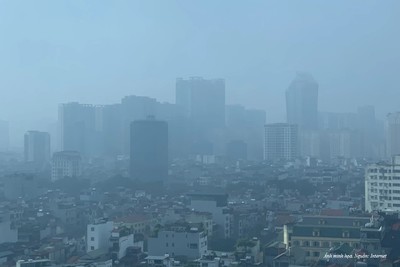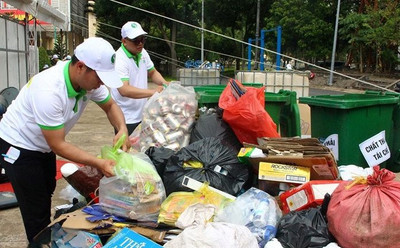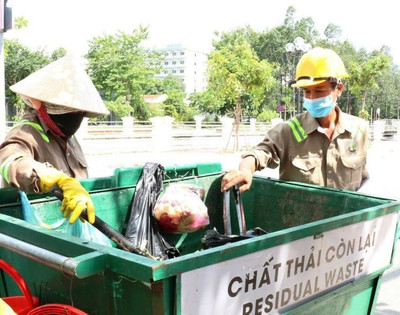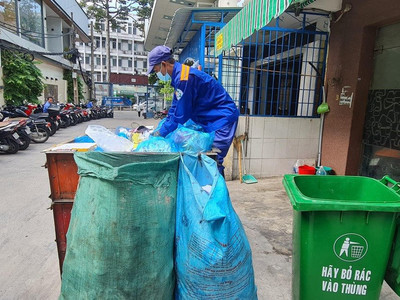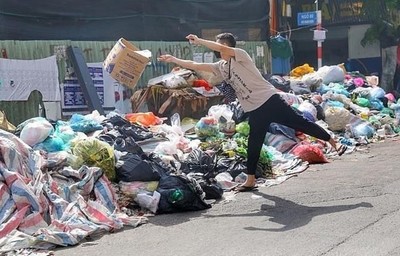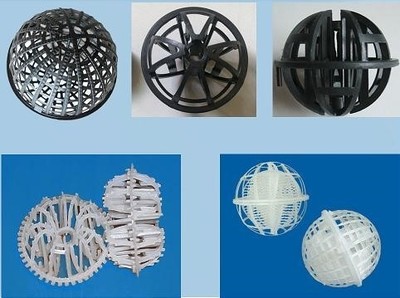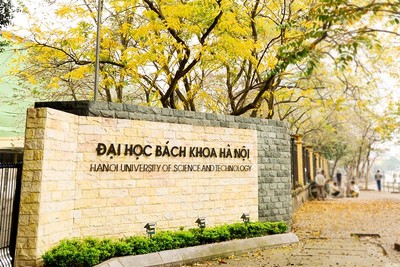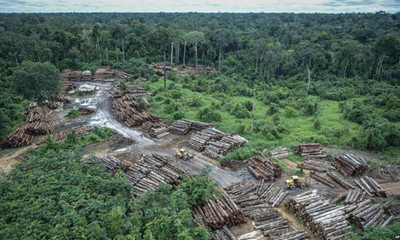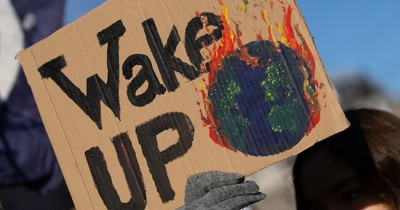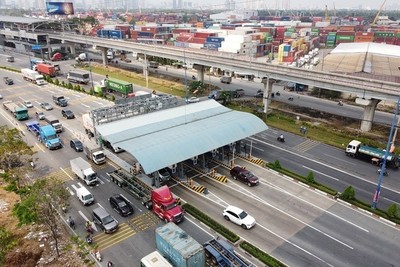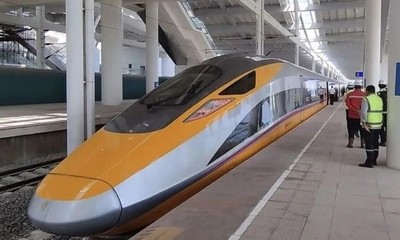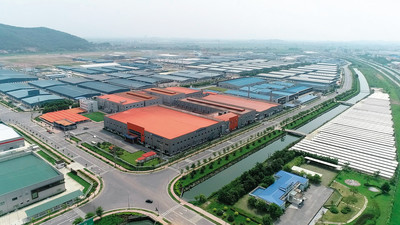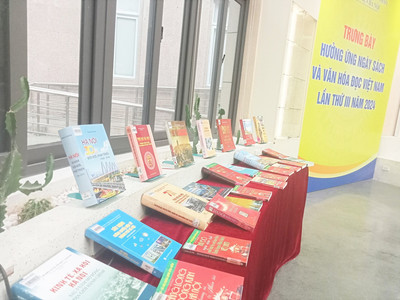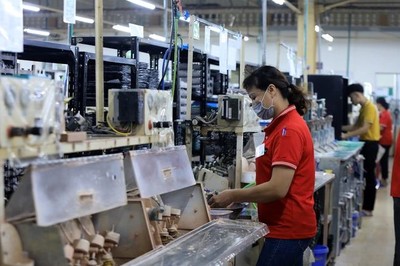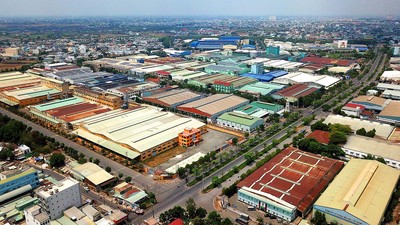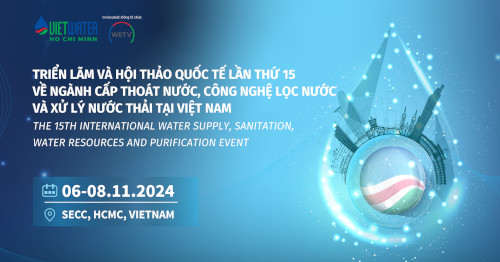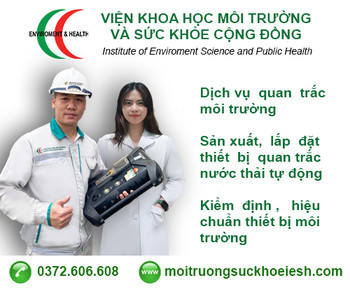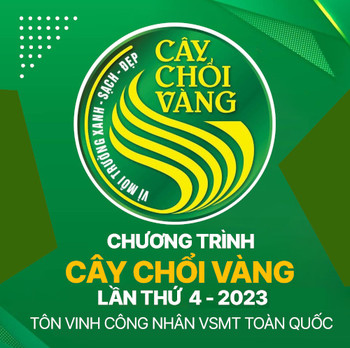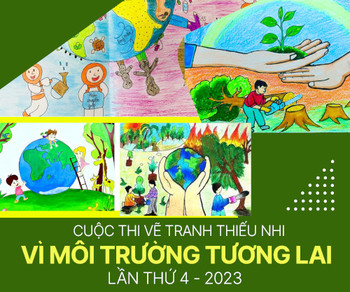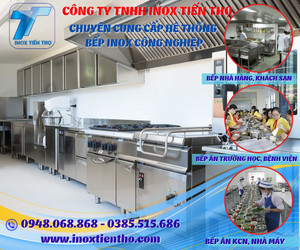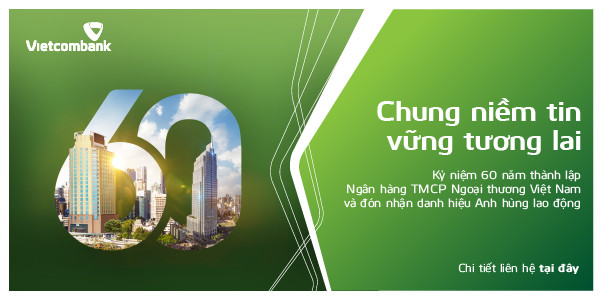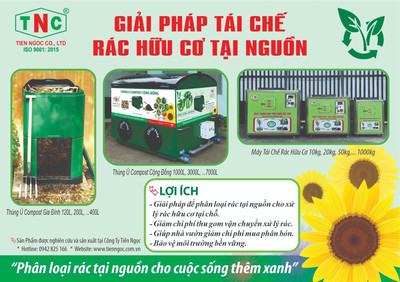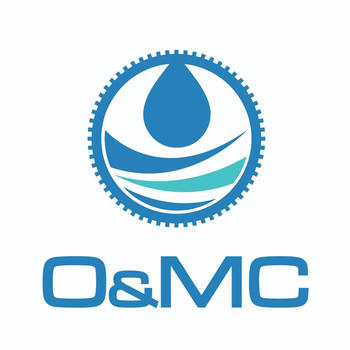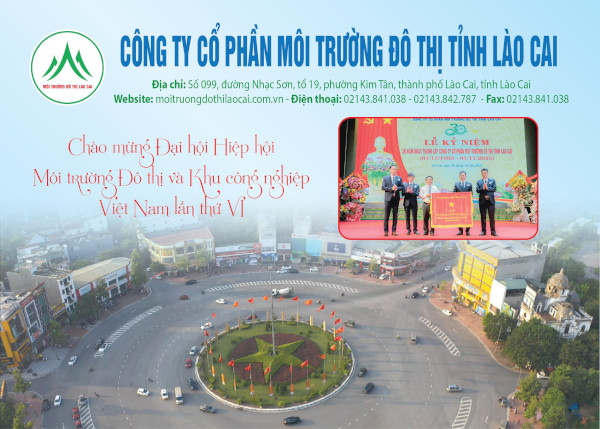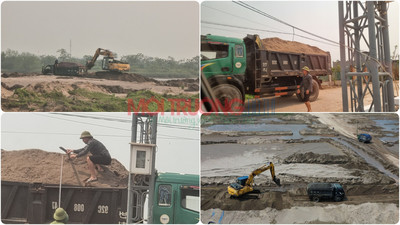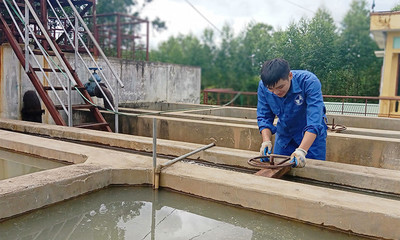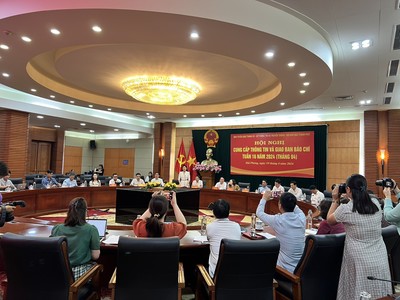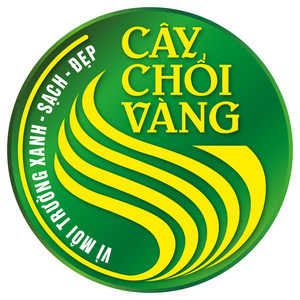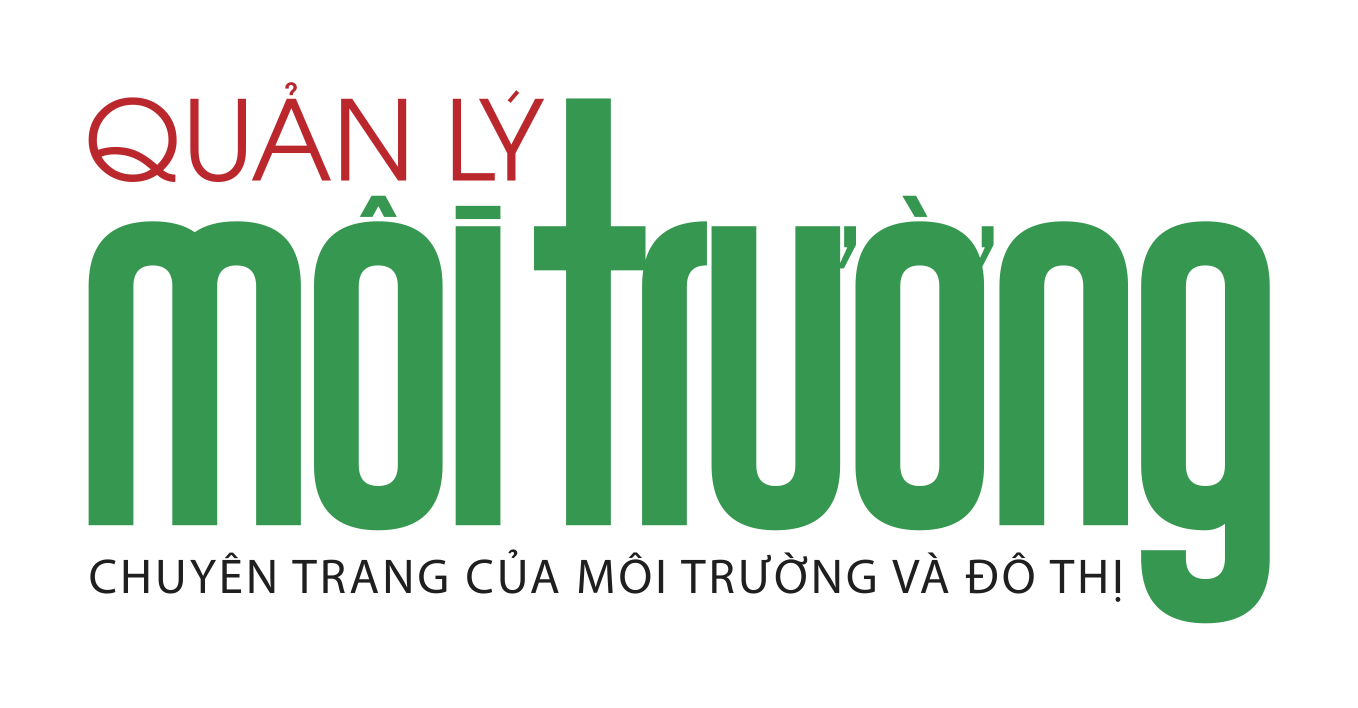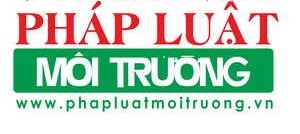Công bố quốc tế lĩnh vực môi trường số 44-2022
Trân trọng giới thiệu tới quý độc giả Công bố quốc tế lĩnh vực môi trường số 44-2022 với những nội dung chính như sau:
Về quản lý môi trường
- Phân tích đa nhân tố và phân tích dự đoán đa kịch bản phân tách về lượng khí thải carbon của Trung Quốc theo mục tiêu carbon kép.
- Ô nhiễm không khí phục hồi và các chế độ phục hồi khác nhau trong thời gian nới lỏng các hạn chế COVID-19.
- Sự biến đổi và thay đổi của khí hậu là nguyên nhân dẫn đến bệnh nhiễm khuẩn salmonella ở Úc: 1991 đến 2019.
- Dịch tễ học dựa trên nước thải ở các nước có xử lý nước thải kém - Chức năng chỉ thị dịch tễ học của SARS-CoV-2 RNA ở nước mặt.
- Các nghiên cứu về dịch vụ hệ sinh thái ở Thổ Nhĩ Kỳ: Đánh giá quy mô quốc gia.
- Hướng tới du lịch bền vững hơn theo cách tiếp cận khí thải carbon: Nghiên cứu điển hình của Camino Lebaniego.
- Phát triển tài chính và đổi mới xanh, các giải pháp tối ưu cho một xã hội bền vững với môi trường: Bằng chứng từ các nền kinh tế hàng đầu.
- Đánh giá tác động kinh tế và sự nóng lên toàn cầu của các quy trình xử lý bùn thải phổ biến ở Bắc Mỹ.
- Phân bổ nguồn tổng hợp các chất ô nhiễm không khí và carbon dioxide dựa trên các phép đo trực tuyến.
- Công nghiệp 4.0 và nền kinh tế vòng tròn trong kỷ nguyên chuỗi giá trị toàn cầu: Chúng ta đã học được gì và còn điều gì cần khám phá?
Về môi trường đô thị
- Việc cải thiện công bằng không gian của không gian xanh đô thị có thể giảm thiểu tác động của đảo nhiệt đô thị không?
- Những tiến bộ gần đây về sự hình thành SOA trong không khí trong nhà, số phận và các chiến lược để xác định đặc tính SOA trong không khí trong nhà.
- Định lượng mô hình không gian của các đảo nhiệt đô thị và hiệu ứng làm mát liên quan của cảnh quan xanh lam - xanh lá cây bằng cách sử dụng dữ liệu viễn thám đa nguồn.
- Đặc điểm quy trình và hoạt động tự cung cấp năng lượng của lò phản ứng sinh học màng động học kỵ khí ít tắc nghẽn để xử lý nước thải đô thị tập trung.
- Hiệu quả theo loài cụ thể trong việc loại bỏ PM2.5 bởi cây đô thị: Từ các phép đo lá đến các ước tính mô hình được cải thiện.
- Ô nhiễm không khí có ảnh hưởng đến giá nhà ở đô thị? Bằng chứng từ 285 thành phố cấp tỉnh của Trung Quốc.
- Các mô hình tối ưu hóa sắc nét và mờ nhạt để quản lý chất thải rắn đô thị bền vững.
- Tác động của các hình thái đô thị và các yếu tố kinh tế xã hội đến phát thải CO2: Phân tích kinh tế lượng không gian.
- Đánh giá các chiến lược và hiệu quả của chúng trong việc giảm sự truyền qua không khí trong nhà và cải thiện chất lượng không khí trong nhà.
Về môi trường khu công nghiệp
- Xử lý thực vật đối với nước thải công nghiệp bị ô nhiễm bằng bèo tấm (Lemna minor L.): Tăng trưởng và phản ứng sinh lý khi sử dụng axit axetic.
- Phân tích môi trường và sinh thái công nghiệp bền vững: Một trường hợp của sợi nhựa etilen melamine.
- Phương pháp tiếp cận máy học để dự đoán và đánh giá tỷ lệ chịu tải của đất ổn định chứa chất thải công nghiệp ở California.
- Các chế độ của công nghệ cho phép chủ chốt ảnh hưởng như thế nào đến quá trình chuyển đổi công nghệ xã hội: Tác động của trí tuệ nhân tạo đối với quá trình khử cacbon trong ngành thép.
- Quy tụ công nghiệp ảnh hưởng như thế nào đến phát triển kinh tế chất lượng cao? Bằng chứng từ Vòng kinh tế Thành Đô-Trùng Khánh ở Trung Quốc.
- Phối hợp phân bổ tài nguyên nước và giấy phép phát thải nước thải dựa trên mô hình tối ưu hóa đa mục tiêu: Từ góc độ mâu thuẫn giữa công bằng và lợi ích kinh tế.
- Khảo sát và mô hình hóa động học nhiệt phân của chất thải sinh khối công nghiệp.
- Xử lý nước thải công nghiệp nhà máy chưng cất (DIW) bằng sự kết hợp của quy trình sono (Mỹ), quang ảnh (UV) và đông tụ điện (EC).
- Khử cacbon trong ngành công nghiệp vôi: Công nghệ tiên tiến.
Xin trân trọng giới thiệu!
QUẢN LÝ MÔI TRƯỜNG
1. Multi-factor decomposition and multi-scenario prediction decoupling analysis of China's carbon emission under dual carbon goal
Science of The Total Environment, Volume 841, 1 October 2022, 156788
Abstract
Comprehensively clarifying China's carbon emission factors and formulating effective strategies are essential and significant for achieving the "30–60” dual carbon target. This manuscript proposed a novel hierarchical framework of multi-factor decomposition, comprehensive evaluation, prediction, and decoupling analysis of the carbon emission. The multi-factor decomposition model from the perspectives of energy, economy, and society based on the expanding the Kaya Identity and LMDI decomposition method can provide the quantification results. On this basis, this manuscript applies the entropy weight method to construct the evaluation system and generate the index from the environment, energy, and economy dimensions for China's six power generation modes. Furthermore, the carbon emission dynamics model is built based on the carbon emission data in the past 40 years and used to predict China's carbon emission in the next 40 years under multi scenarios combined with Tapio's decoupling theory. The results show that income per capita and thermal power generation result in carbon emission, while energy price and intensity are decreasing. Moreover, reducing energy consumption and increasing the proportion of renewable energy are effective ways to make China's carbon emission peak in 2030, with a peak value of 12.276 billion tons. Eventually, with policies implemented, carbon emission, economic growth, and social development are predicted to reach a strong decoupling state, indicating long-lasting negative correlations. In summary, this study will provide a comprehensive analytical solution for factor decomposition, integrated assessment, and predictive decoupling of carbon emission from a national level, aiming to provide scientifically reasonable suggestions for policies and regulations for the "dual carbon” goal.
2. Air pollution rebound and different recovery modes during the period of easing COVID-19 restrictions
Science of The Total Environment, Volume 843, 15 October 2022, 156942
Abstract
Although COVID-19 lockdown policies have improved air quality in numerous countries, there is a lack of empirical evidence on the extent to which recovery has resulted in air pollution rebound, and the differences and similarities among regions' recovery modes during the period of easing COVID-19 restrictions. Here, we used daily air quality data and the recovery index constructed by a city-pair inflow index for 119 cities in China to quantify the impact of recovery on air pollution from March 2 to October 30, 2020. Findings show that recovery has significantly increased air pollution. When the recovery level increased by 10 %, the concentration of PM2.5, SO2, and NO2 respectively deteriorated by 1.10, 0.33, 1.25 μg/m3, and the average growth rates of three air pollutants were about 3 %–6 %. Moreover, we used the counterfactual framework and time series clustering with wavelet transform to cluster the rebound trajectory of air pollution for 17 provinces into five recovery modes. Results show that COVID-19 has further intensified regional differentiations in economic development ability and green recovery trend. Three northwestern provinces dependent on their resource endowments belong to energy-intensive recovery mode, which have experienced a sharp rebound of air pollution for two months, thereby making green recovery more challenging to achieve. Three regions with a diversified industrial structure are in industrial-restructuring recovery mode, which has effectively returned to a normal level through adjusting industrial structure and technological innovation. Owing to local policies and the outbreak of COVID-19 in other countries, six provinces in policy-oriented and international trade-oriented recovery modes have not fully recovered to the level without COVID-19 until October 2020. The result highlights the importance of diversifying industrial structure, technological innovation, policy flexibility and industrial upgrading for different recovery modes to achieve long-term green recovery in the future.
3. Climate variability and change are drivers of salmonellosis in Australia: 1991 to 2019
Science of The Total Environment, Volume 843, 15 October 2022, 156980
Abstract
Salmonellosis is a climate-sensitive gastroenteritis with over 92 million cases and over 50,000 deaths a year globally. Australia has high rates of salmonellosis compared with other industrialised nations. This study used a negative binomial time-series regression model to investigate the association between Australian salmonellosis notifications and monthly climate variables including El Niño Southern Oscillation (ENSO) and mean temperature anomaly from 1991 to 2019.
Between 1991 and 2019 in Australia there were 275,753 salmonellosis notifications and the median annual rate for salmonellosis was 40.1 per 100,000 population. Salmonellosis notifications exhibited strong seasonality, reaching a peak in summer and a minimum in winter. There was an estimated increase of 3.4 % in salmonellosis cases nationally per 1 °C increase in monthly mean temperature anomaly (incidence rate ratio [IRR] of 1.034, 95 % confidence interval [CI]: 1.009, 1.059). Similar associations between salmonellosis and mean temperature anomaly were found for some states. Mean temperature anomaly exhibited an upward trend of 0.9 °C over the period 1991 to 2019. Additionally, a positive association was found between salmonellosis in Australia and ENSO whereby El Niño periods were associated with 7.9 % more salmonellosis cases compared to neutral periods (IRR 1.079, 95 % CI: 1.019, 1.143). A similar ENSO association was detected in the two eastern states of New South Wales and Queensland. This study suggests public health preventative measures to reduce salmonellosis could be enhanced in some regions during El Niño as well as during times of increased temperatures.
4. Wastewater-based epidemiology in countries with poor wastewater treatment — Epidemiological indicator function of SARS-CoV-2 RNA in surface waters
Science of The Total Environment, Volume 843, 15 October 2022, 156964
Abstract
Wastewater-based epidemiology (WBE) surveillance of COVID-19 and other future outbreaks is a challenge for developing countries as most households are not connected to a sewerage system. In December 2019, SARS-CoV-2 RNA was detected in the Danube River at a site severely affected by wastewaters from Belgrade. Rivers are much more complex systems than wastewater systems, and efforts are needed to address all the factors influencing the adoption of WBE as an alternative to targeting raw wastewater. Our objective was to provide a more detailed insight into the potential of SARS-CoV-2 surveillance in Serbian surface waters for epidemiological purposes. Water samples were collected at 12 sites along the Sava and Danube rivers in Belgrade during the fourth COVID-19 wave in Serbia that started in late February 2021. RNA was concentrated using Amicon Ultra-15 centrifugal filters and quantified using RT-qPCR with primer sets targeting nucleocapsid (N1 and N2) and envelope (E) protein genes. Microbiological (faecal indicator bacteria and human and animal genetic faecal source tracking markers), epidemiological, physicochemical and hydromorphological parameters were analysed in parallel. From 44 samples, SARS-CoV-2 RNA was detected in 31, but only at 4 concentrations above the level of quantification (ranging from 8.47 × 103 to 2.07 × 104 gc/L). The results indicated that surveillance of SARS-CoV-2 RNA in surface waters as ultimate recipients could be used as an epidemiological early-warning tool in countries lacking wastewater treatment and proper sewerage infrastructure. The performance of the applied approach, including advanced sampling site characterization to trace and identify sites with significant raw sewage influence from human populations, could be further improved by adaptation of the methodology for processing higher volumes of samples and enrichment factors, which should provide the quantitative instead of qualitative data needed for WBE.
5. Ecosystem services studies in Turkey: A national-scale review
Science of The Total Environment, Volume 844, 20 October 2022, 157068
Abstract
The concept of "Ecosystem Services (ES)” has gained global importance since the 1990s. Today its link to sustainable development and human welfare is well documented. However, the level of know-how and the scale and effectiveness of practices differ significantly around the globe. The Ecosystem Services Partnership (ESP) National Network of Turkey aims to fill gaps in ES research and foster collaboration among experts in the public and academic sectors and non-governmental organizations. Therefore, a comprehensive review of ES studies was carried out with rigorous literature research. The review of 247 publications showed that ES research has advanced in the last two decades principally as a result of academia's impetus but increasing efforts in the science-policy interface have also supported its integration into diverse policy sectors. Among all ES, regulating ES were studied more intensely due to the growing effects of climate change on leading economic sectors such as agriculture, forestry, and water management. Monetary valuation and trade-off knowledge have remained low, based on the difficulties in data availability and assessment methods. Although protected areas are critical to biodiversity conservation, the ES concept has not been integrated into protected area management. Therefore, the ES knowledge in Turkey needs to be scaled up to cover the national level, with higher stakeholder engagement and more focused implementation driven by political will.
6. Towards more sustainable tourism under a carbon footprint approach: The Camino Lebaniego case study
Journal of Cleaner Production, Volume 369, 1 October 2022, 133222
Abstract
From an economic point of view, the tourism sector is one of the most important in the world with religious tourism, such as pilgrimages, being a growth area. Tourism activities also make a significant contribution to CO2 emissions (roughly 8% of the world's carbon emissions). In this framework, the main objective of this research is to develop an integrated sustainable model by assessing the impact of pilgrimages to the Camino Lebaniego (Lebaniego Way) in the Cantabrian region, which is one of the most popular routes in northern Spain. To do this, it is necessary to quantify the environmental impacts of this activity since this is a key element in establishing appropriate and effective environmental management programmes. This study uses the Life Cycle Assessment (LCA) method, focused on the Carbon Footprint (CF) impact category, to assess the greenhouse gas (GHG) emissions of this activity considering ‘a pilgrim who completes the route in three days’ as the selected functional unit (FU). In addition, the sub-sectors of accommodation, food and beverages, and waste management are taken into account. Following this route generated a total of 13.69 kg CO2 eq./FU, of which accommodation and the services offered there contributed almost 71.47%, food was 17.08%, and waste management 11.45%. The evening meal and propane consumption were the hotspots in the hostel, accounting for almost 74% of the total impact, so alternatives were proposed to reduce the impacts associated with these. In terms of transport, it was found that for the same destination, it was better to use a car rather than a plane, because the associated CO2 emissions were lower. Finally, these aspects are discussed and improvement measures for reducing GHG emissions are proposed, involving the introduction of good practices and environmental commitments from the pilgrims themselves, as well as enterprises and local communities. Ecolabels and environmental certifications should become a key tool for sending this signal to the market as should the use of public transport to the destination, among other actions. Ultimately, religious and nature tourism seems to be on the upturn, and it is likely that pilgrimage routes could be the next post-COVID travel trend.
7. Financial development and green innovation, the ultimate solutions to an environmentally sustainable society: Evidence from leading economies
Journal of Cleaner Production, Volume 369, 1 October 2022, 133223
Abstract
The surge of economic activities in the world's top economies has resulted in a cumulative 57% of the world's pollution, leaving an innate impact on global environmental sustainability goals. This study investigates if financial development and green innovation play some role in de-escalating the pressing environmental challenges worldwide. By developing a comprehensive index for financial development, green innovation, and environmental sustainability from 2000 to 2019, this study aims to assess the impact of financial development and green innovation on environmental sustainability in the presence of renewable energy, non-renewable energy, industrial value-added, urbanization, gross domestic product, research and development and foreign direct investment as additional control variables. The Cross-section dependence and second-generation unit root tests have been deployed to rectify the data properties. Serving as the primary study model, the results of the panel threshold model shows that green innovation has a substantial impact on environmental sustainability and proves to be an effective tool for reducing the environmental pollution. Financial development also has a significant relationship with environmental sustainability, highlighting the significance of financial development in addressing environmental challenges. The robustness GMM test assured the validity of the study results, and granger causality reveals the substantial long-run impact of financial development and green innovation on environmental sustainability in leading economies. The present study helps policymakers and stakeholders identify the importance of green innovation and financial development to lessen environmental impacts while highlighting the role of energy choices in pursuit of long-run environmental interests.
8. An economic and global warming impact assessment of common sewage sludge treatment processes in North America
Journal of Cleaner Production, Volume 370, 10 October 2022, 133539
Abstract
This study details a probabilistic life cycle assessment model to evaluate the environmental (i.e., global warming potential) and economic impact of four common sewage sludge treatment methods (anaerobic digestion, incineration, composting and pyrolysis) coupled with their most common end-of-life scenarios for the North American context. The model is subsequently applied to a realistic case study where each technology is assessed over a 10-year analysis period based on data made available by a Canadian municipality. For the case study, pyrolysis and anaerobic digestion coupled with agricultural land application have an expected global warming impact at least 46% and 60% lower, respectively, than the alternative treatment methods. Conversely, composting and pyrolysis have an expected life cycle cost at least 32% and 27% lower, respectively, than the competing treatment alternatives. Composting is able to achieve its relatively low life-cycle costs through the affordability of the required capital investments; conversely, pyrolysis is able to reduce its life-cycle cost through the recovery of valuable resources such as energy, fertilizer, and fuel. These findings and the resulting tool from this work will aid decision-makers as they seek sustainable sewage sludge treatment strategies.
9. Ensemble source apportionment of air pollutants and carbon dioxide based on online measurements
Journal of Cleaner Production, Volume 370, 10 October 2022, 133468
Abstract
Air pollution and climate change have attracted worldwide attention due to their significant threats to human health and the environment. To maximize the co-benefits of clean air policies on greenhouse gas emissions and vice versa, it is imperative to coordinate emission control measures for air pollutants and carbon dioxide (CO2). To do this, we first need to better quantify the impacts of different sources to air pollutants and CO2 at once. Based on a 2-year observation of fine particulate matter (PM2.5), gaseous pollutants (including sulfur dioxide (SO2), nitrogen oxides (NOx), initial volatile organic compounds (In–VOCs)), as well as CO2, we apportioned the sources of criteria air pollutants and CO2 simultaneously. We then developed a new source apportionment method to quantitatively determine the relative impacts of different emission sources on (1) gaseous pollutants ensemble (SO2-NOx-In-VOCs) and (2) PM2.5 and CO2 ensemble (PM2.5-CO2). The results demonstrate that vehicle exhaust (35%), industrial emissions (31%), biomass burning (18%), and coal combustion (16%) were the main control targets for the SO2-NOx-In-VOCs ensemble, and they were also the dominant contributors to PM2.5-CO2 ensemble with similar contribution rates. Not surprisingly, the source impacts are substantially different for the two studied ensembles to those of individual air pollutant alone. This study provides a new source apportionment method to deliver scientific evidence for developing a coordinated strategy to maximize the benefits of clean air and carbon policies to air quality and the climate.
10. Industry 4.0 and circular economy in an era of global value chains: What have we learned and what is still to be explored?
Journal of Cleaner Production, Volume 371, 15 October 2022, 133621
Abstract
This article reviews the industry 4.0 (I4.0) and circular economy (CE) literature from a global value chain (GVC) perspective. More specifically, it (1) summarizes the empirical findings on the applications of I4.0 and CE practices; (2) explores the previous literature and identifies several future research directions to advance the existing literature. In this respect, the interface between I4.0 and CE research is a relatively young field of inquiry that has been little concerned with developments in GVCs. We systematically review 112 peer-reviewed papers in the field of I4.0 and CE to distill key future research opportunities and trends in the GVC field. We develop three specific conclusions from our literature review. First, GVCs can vary widely within the various forms of I4.0 technologies with the various CE practices. Second, GVC research is underdeveloped with regard to I4.0 and CE. Third, our findings are congruent with previously published studies, which recognize the importance of GVC research that has generated a rich body of knowledge, mainly from a governance perspective in operations management, supply chain management, and international business. Likewise, our study offers promising avenues for future research studies at the intersection of I4.0, CE, and GVCs. Our systematic literature review suggests that there are many opportunities to advance the I4.0 and CE debates in the burgeoning field of GVC.
11. Spatial spillover effect of carbon emission trading policy on carbon emission reduction: Empirical data from transport industry in China
Journal of Cleaner Production, Volume 371, 15 October 2022, 133529
Abstract
Carbon emission trading policy (CETP) is an important tool for energy-savings and emission reduction. Currently, the spatial spillover effect of CETP on carbon emission reduction in transport industry is still unknown. To fill this gap, this paper employs a spatial econometric model (SEM) to estimate the spillover effect of CETP on traffic carbon emissions, and further discusses the boundary effect of spatial spillover. Additionally, this paper established a spatial mediating effect model to investigate the transmission mechanism of CETP in reducing traffic carbon emissions, and further discussed the impact of government intervention in carbon emissions trading market. The results showed that CETP had a significant effect on cutting down the traffic carbon emissions in the pilot areas, and that there existed a spatial spillover effect. Moreover, near the threshold of 250 km–650 km, the spillover effect was strongest. Excessive government intervention will cause the carbon market mechanism to fail, which will be bad for reducing traffic carbon emissions. The CETP can promote the traffic carbon emissions by improving the technical research level (Tech) and energy consumption structure (TES). The purpose of this paper was to provide decision-making suggestions for the government to improve and perfect the carbon emission trading mechanism and realize the carbon neutrality of transport industry as soon as possible.
12. The effects of publicly supported environmental innovations on firm growth in the European Union
Journal of Cleaner Production, Volume 372, 20 October 2022, 133429
Abstract
Environmental innovations are considered to align economic and environmental objectives and support environmental policy goals. To test this notion, we estimate the economic effects of environmental innovations that received public financial support across the business economy of 13 Member States of the European Union. Using an instrumental variable approach to address the inherent endogeneity problem, we find that the average publicly supported environmental innovation increases firm employment by 9%, turnover by 12% and market share by 12% over a two-year period, notwithstanding country and sector heterogeneity. Importantly, the results are not driven by highly innovative firms but stem from a broad set of small and medium-sized enterprises with limited innovation activity. Thus, public financial support for environmental innovations appears to be an effective instrument to facilitate the transition to a more sustainable economy
13. Assessment framework and empirical analysis of the ecological protection importance for key town agglomerations in China
Journal of Cleaner Production, Volume 372, 20 October 2022, 133682
Abstract
With urban development, ensuring ecological environmental protection has become an important issue in the planning and development of town agglomerations, and the evaluation of the ecological protection importance (EPI) has become the key to the success of this goal. Although the Chinese government has zoned the ecological importance nationwide, it is still limited as far as its application in actual environmental protection and ecological construction planning in town agglomerations. Based on the spatial identification of the ecological functions in key town agglomerations (KTAs), an EPI framework for KTAs is developed in this study. An ecological conservation importance index is proposed to describe the EPI of the KTAs by utilizing the human settlement protection (HSP) services and ecological sensitivity indicators. Based on multi-source data, a combination of a spatial analysis, a statistical analysis, spatial hierarchical clustering, and other methods was utilized to identification and evaluation. The results showed that (1) the HSP service displayed a more even spatial distribution than the ecological sensitivity; (2) the EPI index of the national KTAs had a normal distribution, primarily concentrated in the medium-important and relatively important town agglomerations; and (3) the EPI indexes of the KTAs have prominent geographical characteristics in their spatial distributions. In addition, the Chinese KTAs could be divided into six regions. This study explains the concept of the EPI index of town agglomerations and proposes an evaluation framework. The framework complements the operational methods for identifying and classifying KTAs in the ”National Ecological Function Zoning”, and provides solutions for formulating the environmental protection zones of town agglomerations.
14. Is the digital economy driving clean energy development? -New evidence from 276 cities in China
Journal of Cleaner Production, Volume 372, 20 October 2022, 133783
Abstract
The digital economy is becoming increasingly important in the field of carbon governance. However, there is little literature examining the relationship between the digital economy and clean energy development. This paper aims to fill this gap by exploring the relationship between the digital economy and clean energy and its spatial effects. We explored the effects of the digital economy using adouble fixed effects model and a spatial econometric model using 276 cities in China from 2011 to 2019 as the original data. We find that the digital economy can drive clean energy development. Technological innovation and city bank loans play an important mediating role in this. Second, we find that market-driven amplifies the positive effects of the digital economy compared with government intervention, and the effects of the digital economy are different under different regions. Finally, we find that the digital economy can drive clean energy not only in local cities, but also indirectly in neighboring cities. These facts suggest that the digital economy is an important way to drive clean energy development and thus effectively achieve sustainable development. Our study provides new ideas for building digital economy and clean energy development in emerging developing countries such as China.
15. The carbon emissions related to the land-use changes from 2000 to 2015 in Shenzhen, China: Implication for exploring low-carbon development in megacities
Journal of Environmental Management, Volume 319, 1 October 2022, 115660
Abstract
Megacities exploit enormous amounts of lands from outside of the city boundary. However, there is a large knowledge gap in the impact of socioeconomic activities associated land-use changes on carbon emissions of megacities during the urbanization. In the current work, we combined the material-flow analysis, environmental extended input–output model, and land matrix data to construct a hybrid network framework. Such a framework was used to estimate the carbon emissions driving from trade between sectors and associated land use changes during 2000–2015 in Shenzhen, China. Results indicated that the total carbon emissions of Shenzhen had a growth rate of 262.7% from 2000 to 2010 and a declining rate of 17.6% from 2010 to 2015. This pattern is associated with large declining rates in the overall energy and carbon intensities by 53.8% and 63.2% during the period of 2000–2015. Meanwhile, embodied carbon emissions of Shenzhen kept rising by approximately twofold, accompanied by the increasing trends in the land-use related carbon emissions both inside and outside of city boundary. The land uses per unit GDP showed a dramatical decline by 85.7% and with a large contribution of the transportation and industrial land, and this caused a gradual increase in overall land-use related emissions with average growth rate of 7.1%. In addition, the land-use change related carbon emissions of the transportation and industrial land had a cumulative growth of 85%. As for the embodied land-use related carbon emissions, the dominated contributor was the Agriculture sector which drove an average of 0.13 MtC yr−1 emissions via importing agricultural products from outside of Shenzhen. This study provides a scientific foundation for corporately mitigate carbon emissions between megacities and their surrounding regions.
16. Research on water resources environmental carrying capacity (WRECC) based on support-pressure coupling theory: A case study of the Guangdong-Hong Kong-Macao Greater Bay Area
Journal of Environmental Management, Volume 320, 15 October 2022, 115805
Abstract
Water scarcity and water pollution problems are becoming increasingly serious in many regions of the world due to rapid socioeconomic development. Water resources environmental carrying capacity (WRECC), which embodies the attributes of social, economic, resource and environmental aspects, is usually considered as a significant metric to guide regional sustainable development. Most existing studies on WRECC mainly focus on conceptual discussions and evaluation methods, lacking a systematic insight into the theoretical connotations of WRECC and neglecting the interaction mechanisms within the WRECC system. Therefore, this study aims to propose a new WRECC evaluation method based on support and pressure theory to deeply reveal the state change and driving mechanisms of WRECC. Firstly, a WRECC evaluation system incorporating support and pressure is constructed and the WRECC performance is determined by both the support index and pressure index. Subsequently, the catastrophe progression method and the obstacle degree model are introduced to quantify the WRECC and identify the primary influencing factors. Lastly, the feasibility and validity of this methodology are verified through an empirical application in the Guangdong-Hong Kong-Macao Greater Bay Area (GBA). The results indicate that the WRECC of the GBA presents an upward trend from 2010 to 2019, shifting from a low-value load state to a low-value surplus state. Moreover, the WRECC performance varies significantly among cities in the GBA, especially for edge cities that generally exhibit higher support, pressure and WRECC indices than central cities. In addition, common obstacles that affect WRECC are total water resources, water resources per capita, water consumption per hectare for agriculture and proportion of the tertiary industry. Furthermore, this study reveals that the coupling relationship between support and pressure develops towards a positive direction, and water environment protection and economic development are the main drivers of WRECC development. This new proposed methodology can provide a theoretical reference for investigating regional WRECC and formulating appropriate sustainable development strategies.
17. How does digital finance influence green technology innovation in China? Evidence from the financing constraints perspective
Journal of Environmental Management, Volume 320, 15 October 2022, 115833
Abstract
Green innovation activities of enterprises often fall into the dilemma of financing constraints. Hence, it is urgent that the financial system develops and becomes innovative, especially for a developing country like China. Existing literature mainly explores the influencing factors of green innovation from the environmental regulation, economic growth and government subsidies perspective. However, few papers critically study how digital finance influences green innovations. To explore the internal influencing mechanism of digital finance on the quantity and quality of green technology innovation, panel data of 271 prefecture-level cities from 2011 to 2019 in China is used. Based on theoretical analysis and empirical research, we get the following conclusions. First, digital finance can improve the quantity and quality of green technological innovation, which has become a significant driving force for green innovations in China. The results are still robust after the endogeneity tests. Second, the results of heterogeneous analysis indicate that the different dimensions of digital finance can improve green innovations. They include breadth of coverage, depth of use, and degree of digitization. The positive effect of digital finance is most substantial in eastern cities, followed by central cities, and weakest in western cities. Third, digital finance indirectly improves green innovation mainly by alleviating financing constraints. Our empirical results provide policy enlightenment for realizing the coordination of China's urban digital transformation and green economic development.
18. Environmental regulations, political risk and consumption-based carbon emissions: Evidence from OECD economies
Journal of Environmental Management, Volume 320, 15 October 2022, 115893
Abstract
The staggering rise in global temperature and abrupt change of climate are the responses of nature alerting humanity to limit the emissions of hazardous gases and adopt environmentally-benign life style. The present study explores empirically whether any changes in environmental policy stringency (EPSI), political risk (PR), and the interaction term of EPSI*PR result in any alteration of consumption-based carbon emissions (CBCE) of the 24 advanced OECD economies over the period of 1990–2020. Prior to the empirical estimations, various diagnostic tests are employed. The empirical techniques include, panel cointegration check, Cross-sectional Augmented Autoregressive Distributed Lags (CS-ARDL), and Dumitrescu & Hurlin panel causality test. The findings confirm that imports, gross domestic product, and stringency of environment policies activate CBCE in short-run. Whereas, a unit improvement in political risk and its interaction with environmental policy stringency give rise to 0.231 MtCO2 of CBCE in long run. Interestingly, the squared term of environmental policy stringency effectively tackles such emissions. Based on the findings, we conclude that the present environment related policies of OECD member states does not effectively limit CBCE. In order to achieve genuine emissions reduction goals, the selected nations should restructure their environment related policies by prioritizing increments in environmental policy stringency along with minimizing the risks involved in the political system.
MÔI TRƯỜNG ĐÔ THỊ
1. Can improving the spatial equity of urban green space mitigate the effect of urban heat islands? An empirical study
Science of The Total Environment, Volume 841, 1 October 2022, 156687
Abstract
The role of urban green space (UGS) in mitigating the urban heat island (UHI) effect has been demonstrated in a growing body of literature. However, the potential influence of the spatial equity of UGS distribution on the UHI effect has largely been overlooked. The present study aims to identify this potential influence using the spatial equity of UGS and the land surface temperature (LST) as measures of UGS spatial distribution and UHIs, respectively. A comprehensive spatial distribution map of UGS was generated by combining the UGS coverage fraction data within urban impervious pixels and the green cover data outside urban impervious pixels. Then, the spatial equity of UGS distribution across all urban impervious pixels was determined using the Gini coefficient. In addition, an LST map was derived using the thermal infrared spectral bands of Landsat 8 OLI/TIRS products. A case study of Dongguan, a highly urbanized city in China, showed that (1) the distribution of both UGS and LSTs were spatially aggregated in all the towns of the city, (2) the LST of urban impervious pixels was negatively correlated with the area of surrounding UGS, and (3) the Gini coefficient of UGS was positively correlated with the proportion of hot and cool areas, but negatively correlated with the proportion of medium-hot and medium-cool areas. These findings indicate that increasing the amount of UGS is beneficial to the reduction of urban average LSTs, while promoting the spatial equity of UGS distribution is conducive to reducing the spatial aggregation of LSTs within urban areas, thereby improving the overall urban thermal environment. Therefore, as a nature-based solution, promoting the spatial equity of UGS distribution could enhance the overall cooling effect of UGS more effectively at the city scale, and thus further underpin the sustainable development of the urban environment.
2. Recent advances on SOA formation in indoor air, fate and strategies for SOA characterization in indoor air - A review
Science of The Total Environment, Volume 843, 15 October 2022, 156948
Abstract
Recent studies proves that indoor air chemistry differs in many aspects from atmospheric one. People send up to 90 % of their life indoors being exposed to pollutants present in gas, particle and solid phase. Particle phase indoor is composed of particles emitted from various sources, among which there is an indoor source – secondary chemical reactions leading to formation of secondary organic aerosol (SOA). Lately, researchers' attentions turned towards the ultrafine particles, for there are still a lot of gaps in knowledge concerning this field of study, while there is evidence of negative influence of ultrafine particles on human health. Presented review sums up current knowledge about secondary particle formation in indoor environment and development of analytical techniques applied to study those processes. The biggest concern today is studying ROS, for their lifetime in indoor air is very short due to reactions at the very beginning of terpene oxidation process. Another interesting aspect that is recently discovered is monoterpene autooxidation process that leads to HOMs formation that in turn can influence SOA formation yield. A complex studies covering gas phase and particle phase characterization, but also toxicological studies are crucial to fully understand indoor air chemistry leading to ultrafine particle formation.
3. Quantifying the spatial pattern of urban heat islands and the associated cooling effect of blue–green landscapes using multisource remote sensing data
Science of The Total Environment, Volume 843, 15 October 2022, 156829
Abstract
Surface urban heat islands (SUHIs) are a global concern. Although their spatial pattern and the cooling effect of blue-green landscapes have been documented, exploring more accurate and quantitative results is still necessary. For Hangzhou, we combined nighttime light (NTL) data with LST images to investigate the spatial morphology of SUHIs and analyze the cooling effect of blue–green landscapes. The radiative transfer equation (RTE) method was used to derive the land surface temperature (LST). Then, based on the unique feature of Luojia1-01 NTL data, the concentric zone model (CZM) was proposed to depict the urban spatial structure. The CZM was applied to construct a number of equal-area concentric belts along the urban-rural gradient to determine the SUHI range and the corresponding blue–green landscape cooling effects. Finally, local Moran's I indices were adopted to identify the cold-hot spots of the SUHI and the relationship with land use. The minimum, average and maximum LSTs were 21.81 °C, 32.79 °C and 44.79 °C, respectively. Additionally, 59.16 % of the study area was affected by the SUHI, and the mean LST inside the SUHI was 36.4 °C, clearly higher than that of the rural area. The SUHI hotpots were clustered in regions with intensive human activities, forming archipelagos. Due to the different blue–green landscape densities, the cooling capacity had spatial heterogeneity in different urban rural belts (URBs), and the cooling capacity of URB16 was approximately 71 times that of URB1. The cooling efficiency increased with blue–green landscape density in general; hence, blue–green landscape density thresholds of 40 % and 70 % were recommended in the urban planning of different urban function zones. Relating the pattern of NTL data to LST images provide meaningful insight into the spatial pattern of SUHIs and the optimization of urban planning.
4. Process characteristics and energy self-sufficient operation of a low-fouling anaerobic dynamic membrane bioreactor for up-concentrated municipal wastewater treatment
Science of The Total Environment, Volume 843, 15 October 2022, 156992
Abstract
Up-concentration of municipal wastewater using physico-chemical methods can effectively enrich organic matter, facilitating subsequent anaerobic digestion of up-concentrated wastewater for enhanced methanogenesis at reduced energy consumption. An anaerobic dynamic membrane bioreactor (AnDMBR) assisted with biogas-sparging was developed to treat up-concentrated municipal wastewater, focusing on the effects of operating temperature and hydraulic retention time (HRT) as well as COD mass balance and energy balance. The COD removal stabilized at about 98 % over the experimental period, while gaseous and dissolved methane contributed 43–49 % and 2–3 % to the influent COD reducing greenhouse gas emissions. The formed dynamic membrane exists mainly as a heterogeneous cake layer with a uneven distribution feature, ensuring the stable effluent quality. Without adopting any physico-chemical cleaning, the transmembrane pressure (TMP) maintained at a low range (2.7 to 14.67 kPa) with the average TMP increasing rate of 0.089 kPa/d showing a long-term low-fouling operation. Increasing the concentration ratio, the methane production rate decreased from 0.18 to 0.15 L CH4/gCOD likely due to the accumulation of particulate organics. Microbial community analysis indicated the predominant methanogenic pathway shifted from hydrogenotrophic to acetoclastic methanogenesis in response to the temperature change. Net energy balance (0.003–0.600 kWh/m3) can be achieved only under room temperature (25 °C) rather than mesophilic conditions (36 °C).
5. Species-specific efficiency in PM2.5 removal by urban trees: From leaf measurements to improved modeling estimates
Science of The Total Environment, Volume 844, 20 October 2022, 157131
Abstract
The growing population in cities is causing a deterioration of air quality due to the emission of pollutants, causing serious health impacts. Trees and urban forests can contribute through the interception and removal of air pollutants such as particulate matter (PM). The dry deposition of PM by vegetation depends on air pollutant concentration, meteorological conditions, and specific leaf traits. Several studies explored the ability of different plant species to accumulate PM on leaf structures leading to the development of models to quantify the PM removal. The i-Tree Eco is the most used model to evaluate ecosystem services provided by urban trees. However, fine particulate matter (PM2.5) removal is still calculated with a poorly evaluated function of deposition velocity (which depends on wind speed and leaf area) without differentiating between tree species. Therefore, we present an improvement of the standard model calculation introducing a leaf trait index to distinguish the species effect on PM net removal. We also compared model results with measurements of deposited leaf PM by vacuum filtration. The index includes the effect of morphological and functional leaf characteristics of tree species using four parameters: leaf water storage, deposition velocity, resuspension rate and leaf washing capacity. Leaves of 11 common urban tree species were sampled in representative areas of the city of Ferrara (Italy) and at different times of the year from 2018 to 2021. This includes four deciduous broadleaf trees (Tilia cordata, Platanus acerifolia, Acer platanoides, Celtis australis), three evergreen broadleaf trees (Quercus ilex, Magnolia grandiflora, Nerium oleander), and four conifers (Thuja orientalis, Cedrus libani, Pinus pinaster, Picea abies). The results provide significant advancement in assessing PM removal using decision support tools such as models to properly select tree species for future urban tree planting programs aimed at improving air quality.
6. On inorganic tracers of wastewater treatment plant discharges along the Marque River (Northern France)
Chemosphere, Volume 305, October 2022, 135413
Abstract
Increase of water quality in aquatic systems has become a hot button issue in recent decades. However, with the aim to implement an effective remediation strategy, the first step is to identify the sources of diffuse and pointsource pollution using several tracers. In urban areas, B isotopes, Gd enrichment, Cl− or carbamazepine concentrations can be used as wastewater treatment plant tracers. In this study, a focus was made on the quantification of a wide variety of inorganic compounds (elements, ions, isotopic ratios) all along the Marque River, a small stream located in Northern France receiving effluents coming from seven wastewater treatment plants (WWTPs). The objectives were (i) to determine the importance of the WWTPs discharge during low water events, (ii) to assess the efficiency of conventional tracers in quantifying the contribution of the WWTPs and (iii) to investigate new potential tracers less commonly used. The results have shown, through statistical analyses ANOVA (Analysis Of Variance) tests, PCA (Principal Component Analysis) and contribution calculations, that the WWTPs discharges strongly impact the water composition of all the watercourse and particularly during the first 6 km. However, due to high discharges of wastewaters not always well treated, some classical indicators (e.g. B, Rb/Sr) have shown limitations when used alone. The use of a set of relevant tracers including alkali metals could therefore be one solution for overcoming such a problem. Finally, other indicators like Rb/B or Gd/Pt ratios may also be a way to tackle this issue; they are indeed promising to discriminate the source of wastewaters.
7. Does air pollution affect urban housing prices? Evidence from 285 Chinese prefecture-level cities
Journal of Cleaner Production, Volume 370, 10 October 2022, 133480
Abstract
By applying panel data obtained for 285 prefecture-level cities in China from 2005 to 2019, in this paper, we employ the spatial Durbin model to estimate the spatial spillover effects of air pollution on housing prices among neighboring cities. The empirical estimations show that, first, housing prices and PM2.5 concentrations present a significantly positive spatial autocorrelation, implying that significant spatial agglomeration exists among the studied cities. Then, regarding the spatial heterogeneity of air pollution's capitalization effects, we found that air pollution shows a significantly positive relationship with local house prices in large cities and a negative relationship with local house prices in small and medium-sized cities. Additionally, air pollution exerts significantly negative impacts on housing prices in western China but shows no significance in the eastern or central regions. In addition, air pollution exhibits negative capitalization effects on housing values in northern and southern China, and the magnitude of the estimated coefficient in the southern region is smaller than that in the northern region. These findings are robust to an alternating spatial matrix and the explanatory indicators. Our empirical results can help the government develop recommendations for environmental governance and household location choice in China.
8. Crisp and fuzzy optimization models for sustainable municipal solid waste management
Journal of Cleaner Production, Volume 370, 10 October 2022, 133536
Abstract
Increasing municipal solid waste (MSW) generation in the city has caused a serious problem to the authority, especially for emerging countries. Improper management of MSW will increase greenhouse gas (GHG) emissions. Apart from landfill, there are other options to convert MSW into valuable products or energy, such as recycling and incineration. This paper presents crisp and fuzzy optimization models for designing optimal supply chain networks for sustainable MSW management, considering economic (cost minimization) and environmental objectives (emissions reduction). The crisp model is based on a superstructure and consists of material balances, capacity limits and planning constraints for MSW transfer stations, disposal sites and treatment technologies. Fuzzy optimization with max-min aggregation is then incorporated to handle conflicting economic and environmental objectives, as well as uncertainties in GHG emission factors and cost coefficients of MSW treatment. A case study for the design of an optimal MSW supply chain network in the city of Qingdao, China is presented to illustrate the proposed approach. The conflicting objectives of minimizing the total net cost and GHG emissions for MSW transport and treatment are analyzed using the crisp model, yielding a set of Pareto optimal solutions. A compromise solution achieving a 21.6% cost reduction and a 28.4% emissions reduction is identified using the fuzzy model. An inferior solution is also found with smaller cost (19.1%) and emissions reductions (25.1%) due to the use of conservative estimates of uncertain cost coefficients and emission factors. These results demonstrate the effectiveness of the proposed models in dealing with the MSW management problem.
9. Decomposition and decoupling analysis of carbon footprint pressure in China's cities
Journal of Cleaner Production, Volume 372, 20 October 2022, 133792
Abstract
Carbon emission reduction and carbon sequestration are the two key paths to achieve the goal of carbon neutrality. Most of the existing literature focuses on carbon emissions, often ignoring the importance of vegetation carbon sequestration. In this study, a carbon footprint pressure (CFP) index that considers both carbon reduction and carbon sequestration was developed, and the driving factors and decoupling state of China's urban CFP were studied using index decomposition analysis and the Tapio decoupling model. High precision environmental indicators obtained by remote sensing satellites were used to estimate carbon emissions and carbon sequestration data for individual cities. The results show that China's CFP generally had an upward trend from 2000 to 2017, with economic growth and population size being the main drivers for this increase. Additionally, technological progress can effectively alleviate CFP. Only 12.77% of Chinese cities have achieved the decoupling of carbon sequestration from carbon emissions; these are mainly economically underdeveloped cities. Most economically developed cities have been under great pressure to become net zero carbon cities. These cities should pay attention to improving the carbon sequestration capacity of vegetation while reducing carbon emissions.
10. Impacts of urban forms and socioeconomic factors on CO2 emissions: A spatial econometric analysis
Journal of Cleaner Production, Volume 372, 20 October 2022, 133722
Abstract
Planning and development of urban is one of the key factors that affect CO2 emissions. Sustainable urban planning and development is crucial to achieving carbon neutrality. However, there are relatively less studies in quantifying the impacts of urban forms and socioeconomic development on CO2 emissions with considering its spatial autocorrelation effects at the city-level. Thus, this study aimed to analyze the impacts of urban forms and socioeconomic factors on CO2 emissions of cities in Guangdong province during 2000–2017 based on a spatial panel econometric model. The results showed that CO2 emissions of Guangdong province increased significantly with a growth rate of 151% and had obvious spatial clustering characteristics. Urban form and socioeconomic development had a significant impact on CO2 emissions. Specifically, the results indicated that increasing the continuity of urban areas and improving the traffic coupling factor can help reduce CO2 emissions. The economic growth, population increase and economic openness degree increase would lead to stronger CO2 emission. In addition, the spatial spillover effects would enhance such impacts of the driving factors. Specifically, when the spillover effect of spatial Dubin model was taken into account, every 1% increase in urban class area, mean perimeter-area ratio, GDP, population, technology level and urbanization rate would lead a total CO2 emissions change by −0.53%, 1.3%, 1.1%, 0.18%, 12% and 1.4%, respectively. The results suggested that cities in Guangdong province should develop a more compact pattern, urban development with a scattered or disperse pattern should transform towards one continuous core city cluster and city belt, thus enhancing integration and sharing of infrastructure and related policies for low carbon development.
11. A review of strategies and their effectiveness in reducing indoor airborne transmission and improving indoor air quality
Environmental Research, Volume 213, October 2022, 113579
Abstract
Airborne transmission arises through the inhalation of aerosol droplets exhaled by an infected person and is now thought to be the primary transmission route of COVID-19. Thus, maintaining adequate indoor air quality levels is vital in mitigating the spread of the airborne virus. The cause-and-effect flow of various agents involved in airborne transmission of viruses has been investigated through a systematic literature review. It has been identified that the airborne virus can stay infectious in the air for hours, and pollutants such as particulate matter (PM10, PM2.5), Nitrogen dioxide (NO2), Sulphur dioxide (SO2), Carbon monoxide (CO), Ozone (O3), Carbon dioxide (CO2), and Total Volatile Organic Compounds (TVOCs) and other air pollutants can enhance the incidence, spread and mortality rates of viral disease. Also, environmental quality parameters such as humidity and temperature have shown considerable influence in virus transmission in indoor spaces. The measures adopted in different research studies that can curb airborne transmission of viruses for an improved Indoor Air Quality (IAQ) have been collated for their effectiveness and limitations. A diverse set of building strategies, components, and operation techniques from the recent literature pertaining to the ongoing spread of COVID-19 disease has been systematically presented to understand the current state of techniques and building systems that can minimize the viral spread in built spaces This comprehensive review will help architects, builders, realtors, and other organizations improve or design a resilient building system to deal with COVID-19 or any such pandemic in the future.
12. Leveraging blockchain concepts as watermarkers of plastics for sustainable waste management in progressing circular economy
Environmental Research, Volume 213, October 2022, 113631
Abstract
Blockchain-integrated waste management and circular economy are emergent concepts that target minimising waste generation and fluctuations of resource commodity. Blockchain can support a circular economy and green principles by enabling information transparency, reliability and automation. Redesigning plastics by molecular tagging is the way forward to ensure synthetic plastics are kept in an infinite loop and support closed-loop recycling. The involvement of major corporations in product development and blockchain-integrated closed-loop recycling has resulted in several successful green chemical approaches toward circular plastic economy projects. Government policies and legislations are progressively supporting plastic redesigning for improving the plastic circular economy. Nevertheless, a systematic approach is required in addressing blockchain technology and plastic redesigning to effectively leverage circular economy initiatives.
13. Population-environment dynamics across world's top 100 urban agglomerations: With implications for transitioning toward global urban sustainability
Journal of Environmental Management, Volume 319, 1 October 2022, 115630
Abstract
Urbanization is a long-term global trend critical for shaping human-Earth sustainability in the Anthropocene. In past decades, much progress has been made in researching urban sustainability, particularly global assessments of the big picture and case studies of individual cities. Here we examine the world's top 100 urban agglomerations (UAs) in terms of size—that rank high on sustainability agendas and cover 28% of the global UA area—regarding four broadly concerned challenges: population shrinkage, slum development, greenness loss, and heat exposure. Instead of merely focusing on global/regional "averages” or individual cases, we take one step further to identify the "anomalies” of urban sustainability among the 100 UAs for each dimension and on the whole as multi-dimensional coupled infrastructure systems. Results show: (1) urban population of the 100 UAs increased by 36% during 2000–2020; (2) urban slums occurred in 85% of 34 examined UAs in the Global South; (3) urban greenness declined in the 100 UAs by 8% during 2000–2019; and (4) 79% of the 100 UAs were projected to have less than 30 EHDs per year during 2021–2030. Our findings provide global baselines for place-based problem-driven policymaking for the examined UAs and suggest improving urban green infrastructure as their top policy imperative. Our findings point to a critical research gap in the urban sustainability literature: Studying sustainability transitions of the "abnormally” sustainable UAs identified in this study that had exceptional performances on the four examined sustainability dimensions, e.g., Beijing of China and Milan of Italy.
14. Sustainable approach for valorization of solid wastes as a secondary resource through urban mining
Journal of Environmental Management, Volume 319, 1 October 2022, 115727
Abstract
The incessant population has increased the production and consumption of plastics, paper, metals, and organic materials, which are discarded as solid waste after their end of life. The accumulation of these wastes has created growing concerns all over the world. However, conventional methods of solid waste management i.e., direct combustion and landfilling have caused several negative impacts on the environment (releasing toxic chemicals and greenhouse gases, huge land use) besides affecting human health. Therefore, it is requisite to determine sustainable alternative technologies that not only help in mitigating environmental issues but also increase the economic value of the discarded solid wastes. This process is known as urban mining where waste is converted into secondary resources and thereby conserves the natural primary resources. Thus, this review highlights the technological advancements in the valorization process of discarded wastes and their sustainable utilization. We also discussed several limitations of the existing urban mining processes and further the feasibility of valorization techniques was critically analyzed from a techno-economical perspective. This paper recommends a novel sustainable model based on the circular economy concept, where waste is urban mined and recovered as a secondary resource to support the united nations sustainable development goals (SDGs). The implementation of this model will ultimately help the developing countries to achieve the target of SDGs 11, 12, and 14.
15. A cross-scale study on the relationship between urban expansion and ecosystem services in China
Journal of Environmental Management, Volume 319, 1 October 2022, 115774
Abstract
Clarifying the relationship between urban expansion and ecosystem services (ESs) is critical for sustainable management of land resources and ecosystems. However, little is known about the relationship between the two at the cross-scale (particularly at the national-provincial scale). Therefore, we conducted a systematic assessment of the spatiotemporal dynamics and the relationship between urban expansion and ESs including food production (FP), soil conservation (SC), carbon sequestration (CS), and water yield (WY) in China from 1992 to 2020 on the national-provincial scale. The results show that China's urban expansion took up a large amount of cropland, accounting for 79.35% of the newly-added built-up land. Shandong had the largest expansion scale and the highest speed, Shanghai had the most pronounced expansion intensity, and more than 50% of the provinces were dominated by outlying expansion pattern. In terms of total change, the three ESs of FP, SC, and WY increased by 286.5 × 106 t, 1893.61 × 106 t, and 8337.20 × 106 mm, respectively, and CS decreased by 683.90 × 106 Mg C. However, in the urban expansion area, FP and CS net decreased by 1757.6 × 104 t and 19,640.19 × 104 Mg C, respectively, while SC and WY net increased by 347.52 × 104 t and 20,264.11 × 104 mm, respectively. Shandong contributed the most to changes in ESs in urban expansion areas. Urban expansion was significantly negatively correlated with FP and CS with the correlation coefficients > -0.8; it was significantly positively correlated with SC and WY, with coefficients of 0.714 and 0.413, respectively, and urban expansion had a lagged effect on ESs. The impact of urban expansion on ESs had a spatial spillover effect and showed prominent spatial clustering in Anhui, Henan, and Shandong. Based on these results, we proposed urban planning countermeasures grounded in the perspective of ES improvement, which would provide policy references for the sustainable management of the ecological environment and land resources.
16. Promoting public engagement with household waste separation through government social media: A case study of Shanghai
Journal of Environmental Management, Volume 320, 15 October 2022, 115825
Abstract
Government agencies around the world are increasingly using social media to promote public engagement with government-initiated activities, such as Household Waste Separation (HWS). However, existing studies fail to examine how governments can use their official social media accounts to promote public engagement with HWS. This pioneering study investigates the effects of dialogic loop, media richness, content theme, and emotional valence on public engagement with HWS through Government Social Media (GSM). Moreover, the influencing mechanisms are explored by examining the moderating role of social media capital. In total, 1795 posts were scraped from the official Sina Weibo accounts of seventeen Shanghai governments and later analyzed. Results reveal that dialogic loop positively predicts public engagement with HWS through GSM, but media richness negatively affects public engagement. Content themes have significantly different impacts on the level of public engagement with HWS through GSM. Unexpectedly, the effect of emotional valence is not significant. This study is the first of its kind to demonstrate the moderating role of social media capital which is seen to weaken the positive effect of dialogic loop on public engagement with HWS through GSM and mitigate the negative effect of media richness.
MÔI TRƯỜNG KHU CÔNG NGHIỆP
1. Phytoremediation of contaminated industrial wastewater by duckweed (Lemna minor L.): Growth and physiological response under acetic acid application
Chemosphere, Volume 304, October 2022, 135262
Abstract
Extensive usage of heavy metals (HMs) in chemical reactions and processes eventually contaminate the environmental segments and is currently a major environmental concern. HMs such as cadmium (Cd), copper (Cu), lead (Pb), chromium (Cr) and nickel (Ni) are considered the most harmful pollutants as they have adequate potential of bioaccumulation. The current research was carried out to assess the HMs toxicity of textile and tannery wastewater and effect of acetic acid (AA) on phytoextraction of HMs by duckweed (Lemna minor L.) in a hydroponic system. Plants were treated with different treatments having different hydroponic concentrations of AA (5 and 10 mM) and textile and tannery effluents, where these two effuents were equally mixed and then diluted with good quality water with different ratios (25, 50, 75, and 100%) along with three replications of each treatment. Results were recorded for growth attributes, chlorophylls, antioxidant enzymes, electrolytic leakage, reactive oxygen species and HMs accumulation in plants. HMs accumulation disrupts the growth parameters, chlorophyll contents and carotenoids contents along with increased activities of antioxidant enzyme such as catalases (CAT), superoxide dismutase (SOD), peroxidases (POD) and ascorbate peroxidase (APX). Addition of AA in the hydroponic experimental system significantly improves the antioxidant defense mechanism and alleviated the HM induced toxicity in plants. Cr, Cd, Pb, Cu and Ni concentrations were maximally increased up to 116 & 422%, 106 & 416%, 72 & 351%, 76 & 346%, and 41 & 328% respectively under AA (10 mM) application. The results revealed that duckweed can be applied as potential phyto-remedy to treat industrial wastewater.
2. Efficient sonocatalytic degradation of heavy metal and organic pollutants using CuS/MoS2 nanocomposites
Chemosphere, Volume 305, October 2022, 135415
Abstract
Eco-friendly and highly effective catalysts are receiving considerable attention for the removal of heavy-metal ions and organic pollutants. In this study, we developed CuS/MoS2 nanocomposite sonocatalysts to enhance the degradation rate of environmental contaminants by harnessing ultrasonic irradiation. The successful synthesis of nanocomposite sonocatalysts was confirmed by X-ray diffraction (XRD) analysis, and energy-dispersive X-ray spectroscopy. The incorporation of CuS into MoS2 resulted in a flower-like structure with an increased surface area. Importantly, the sonocatalytic efficiency was enhanced by increasing CuS concentration in the nanocomposites, achieving maximum removal efficiencies of 99% and 88.52% for rhodamine B (RhB) and Cr(VI), respectively. In addition, they showed excellent stability and recyclability over five consecutive cycles, without noticeable changes in the nanocomposite structure. Reactive oxygen species (ROS) used for the degradation were identified using ROS scavengers. We believe that this strategy of exploiting nanocomposite sonocatalysts has a great potential in the field of environmental catalysis.
3. Recycling of phosphate tailings and acid wastewater from phosphorus chemical industrial chain to prepare a high value-added magnesium oxysulfate cement
Journal of Cleaner Production, Volume 369, 1 October 2022, 133343
Abstract
Phosphate tailings (PT) and acid water, by-products of phosphorus chemical industrial chain, are usually identified as waste because they can hardly be reused in cement production. This paper proposes an approach of recycling solid waste PT and acid wastewater in preparing a high value-added magnesium oxysulfate (MOS) cement. Results show that the phosphorus in acid water promotes the formation of 5 Mg(OH)2·MgSO4·7H2O (517) phase, thereby improving compressive strength of MOS cement. MOS cement prepared with undiluted acid water present excellent resistance to water and acid. The incorporation of calcined PT lowers the strength of MOS cement but improves the volume stability. The phosphorus and fluorine in acid water are effectively immobilized by the cement matrix. Moreover, recycling of PT and acid water to produce MOS cement not only largely consumes the waste and benefits the environment, but also reduces the cost of waste disposal and cement production.
4. Self-compacting ultra-high performance mortars produced with waste catalysts from petrochemical industry: Rheological, mechanical and microstructural properties
Journal of Cleaner Production, Volume 369, 1 October 2022, 133225
Abstract
The novelty of the study is to investigate the effect of partial replacement of cement by waste catalysts from petrochemical industry on the properties of environmental-friendly self-compacting ultra-high performance mortar. To this aim, the cement was partially replaced by spent catalysts ranging from 0% to 50%. The effects of employing spent catalyst on the rheological (flowability and self-compatibility), mechanical (compressive and flexural properties) and microstructural (porosity, hydration, calcium hydroxide and anhydrous cement) and mixture properties of developed mortars were deeply analysed and discussed. Water demanding addition by decreasing rheology was noticed when the amount of spent catalyst was increased. Higher mechanical strength evaluation with time until 10% replacement of cement by spent catalyst was noticed compared to the reference one which indicated the pozzolanic activity of waste. Microstructure analysis showed that addition of spent catalyst had an influence in decreasing the porosity of developed mortars compared to the reference one. Furthermore, positive influence of using waste catalyst on the cement hydration was observed by reducing the percentage of anhydrous cement and increasing hydration products and calcium hydroxide. Material efficiency analysis showed that, spent catalyst has a potentiality in decreasing cost and increasing environmental efficiency without sacrificing mechanical properties. This can lead to achieving more sustainable and eco-friendly products.
5. Sustainable industrial ecology and environmental analysis: A case of melamine etherified resin fibres
Journal of Cleaner Production, Volume 369, 1 October 2022, 133301
Abstract
Increasing global plastic consumption and its related plastic waste have become a major concern in the world. Achieving sustainable development in the plastics industry requires a systematic insight into all the relevant life cycle phases of plastic products and their environmental impacts. This paper utilises the concepts of industrial ecology and the circular economy to evaluate the three key aspects of thermoset plastic materials and their overall life cycle comprehensively: i) Sustainable production, ii) Recycling to obtain secondary products, and iii) End-of-life behaviour. For all three aspects, their environmental impacts are evaluated additionally using the conceptual Life Cycle Assessment (LCA) approach. The industrial ecology approach, together with LCA is performed on a case study of melamine etherified resin (MER) fibre, which is a high value-added thermoset plastic, difficult to recycle, and, at the end-of-life, potentially emits hazardous compounds. The potential to sustainably produce MER fibre exclusively from renewable and waste sources is explored, closing the loop on the manufacturing and disposal phases. The hydrothermal decomposition of MER fibres into valuable compounds is investigated as a recycling technology. Regarding the end-of-life, a systematic assessment is conducted of the environmental impacts of discharging such material into soil and water bodies. Cleaner production of MER fibres shows the potential to reduce greenhouse gas footprint up to 67%, while analysis of sustainable recycling and disposal highlights important environmental hotspots.
6. Machine learning approach for predicting and evaluating California bearing ratio of stabilized soil containing industrial waste
Journal of Cleaner Production, Volume 370, 10 October 2022, 133587
Abstract
The California bearing ratio (CBR) is one of the important indexes, which is used to represent the strength of subgrade or subbases of pavement. In general, the CBR can be determined through experiments both in the laboratory and field. However, the determination of the CBR is time and cost-consuming as well as low accuracy due to the disturbance of samples and limitations of preparation in the laboratory. Thus, this study estimates the CBR of stabilized soil using twelve machine learning techniques (6 single models and 6 hybrid models). The single models include artificial neural network (ANN), gradient boosting (GB), extreme gradient boosting (XGB), random forest (RF), support vector machine (SVM), and K-nearest neighbors (KNN), while the six hybrid models are a combination of these single models and random restart hill-climbing optimization (RRHC). Twelve models are constructed based on eleven input variables, including cement, Atterberg's limits, optimum moisture content (OMC), maximum dry density (MDD), and dust and ashes. To evaluate the performance of the proposed models, four popular statistical indexes namely mean absolute error (MAE), root mean square error (RMSE), mean absolute percentage error (MAPE), and determination coefficient (R2) were used. The results indicate that among twelve models, four models using GB, RRHC_XGB, RRHC_RF, and RF had a high prediction accuracy (R2 > 0.98) and outperformed than other remaining models. Among these four models, the model using RF has the highest prediction accuracy (R2 = 0.9817, RMSE = 2.3970, MAE = 1.1682, MAPE = 0.0666). According to the result of feature importance analysis using Sklearn permutation importance, SHapley Additive exPlanation (SHAP), individual conditional expectation (ICE), and partial dependence plots-2D, cement and plasticity index (PI) are two most important variables affecting the CBR prediction of stabilized soil. Where, PI was found to be a very crucial factor, which improved the prediction ability of the models compared to the results of previous studies. The results also reveal that when cement content is larger than 2%, there is an insignificant influence of the cement on the CBR of stabilized soil. The value of PI smaller than 15% has a vital impact on the CBR for any values of cement, dust, and ashes. Furthermore, the results also indicate that dust and ash content have less effect on the CBR of stabilized soil. In summary, it can be concluded that this study provides an insightful assessment of the CBR prediction of stabilized soil, and the results of this study can fill the gap in the literature and provide practical knowledge and application on the CBR of stabilized soil.
7. How key-enabling technologies’ regimes influence sociotechnical transitions: The impact of artificial intelligence on decarbonization in the steel industry
Journal of Cleaner Production, Volume 370, 10 October 2022, 133624
Abstract
Key Enabling Technologies (KETs) are pervasive groups of technologies expected to enable innovation. They have been promoted as technologies with tremendous potential for boosting economic growth and sustainability in all sectors of society – a claim whose validity remains underexplored. Building on systems thinking and the Multi-Level Perspective, we develop a novel approach to assess the socio-technical impact of a KET regime on a transitioning sectoral regime. This approach is applied to the case of the Artificial Intelligence (AI) KET impacting the decarbonization of the energy-intensive steel industry. To assess AI's technical impact, we compiled an inventory of AI tools based on reviewing technical scientific articles. Our analysis shows that AI adds technological value to the full range of areas in the steel industry, like predicting process parameters; optimizing operations, scheduling, and electrical energy; and forecasting product demand, quality, and site emissions. Semi-structured interviews were the primary data source to assess AI's broader socio-institutional impact. The results indicate that AI may currently be reinforcing path dependencies of the steel industry, as AI tools are more focused on incremental improvement for existing technologies rather than novel low-carbon technologies. However, AI also offers capabilities to reduce barriers to sustainability innovation, like system integration challenges, flexibility challenges, demand-side barriers, and risk-related barriers. Finally, we reflect on the generalizability of our approach for studying other transitions, and we induce characteristics of the AI-Digital KET regimes. We find that through these characteristics, the AI-Digital KET regime alters existing and creates new system structures (actors, networks, and institutions) within the impacted sector.
8. How does industrial co-agglomeration affect high-quality economic development? Evidence from Chengdu-Chongqing Economic Circle in China
Journal of Cleaner Production, Volume 371, 15 October 2022, 133485
Abstract
Chengdu-Chongqing Economic Circle serves as a comprehensive industrial base and industrial agglomeration area. Its transformation is crucial for high-quality economic development in western China, and industrial co-agglomeration and technological innovation may play a key role. Using panel data of 16 cities in the Chengdu-Chongqing Economic Circle, we evaluate the temporal and spatial patterns of high-quality economic development from 2008 to 2020 to explore the impact of industrial co-agglomeration on high-quality economic development, and how this impact fluctuates when technological innovation is included. The empirical results show that the overall level of high-quality economic development is increasing, while the gap between the cities in the sample is widening. The focal point of high-quality economic development is also moving towards the southeast and its spatial agglomeration is increasingly significant. Industrial co-agglomeration has a positive direct effect on high-quality economic development, but a negative spill-over effect. Technological innovation has a positive and partial mediation effect on industrial co-agglomeration and high-quality economic development. The findings of this study suggest policy makers to accelerate industrial co-agglomeration process and increase technology innovation investment, so as to more efficiently promote the high-quality economic development of Chengdu-Chongqing Economic Circle.
9. Coordinated allocation of water resources and wastewater emission permits based on multi-objective optimization model: From the perspective of conflict between equity and economic benefits
Journal of Cleaner Production, Volume 372, 20 October 2022, 133733
Abstract
Increasing demand for water resources, shortage of fresh water resources and imperfect management of wastewater emission permits compose the main conflicts of water resource in various basins. Therefore, to alleviate these supply and demand conflicts, watershed managers should search for optimal allocation strategies. Overall, there are two challenges in water resource allocation: the first one is the contradictions among various water sectors exacerbated by existed unfair water resource allocation; the second is the unification of wastewater emission permits and water resource allocation while considering economic, social, and environmental benefits. Based on this, a multi-objective optimization model for united allocation of water resources and wastewater emission licenses was proposed in this paper, which takes into account the maximizing of economic benefits per unit of wastewater emission. Applying this model, the balanced development of economic, social, and environmental benefits can be assured, and the equity of water resource allocation to alleviate the supply-demand contradiction can be maximized. An improved particle swarm optimization algorithm was designed to solve the nonlinear programming model and simulate the cooperative allocation scheme of water resources and wastewater emission permits under different preferences. The case study showed that the proposed model is realistic and sensible, and that watershed managers' preferences has an influence on the coordinated allocation strategy of water resources and wastewater emission permits. For example, the economic benefit differential between the basic trade-off scheme (BTS) and the economic benefit maximization scheme (EBM) is 95.39717 billion yuan, and the Gini coefficient between the BTS and the EMS falls from 0.3874 to 0.3627. The proposed model can successfully balance equity and economic benefits, and provide a reference for the construction of wastewater emission and water resource co-allocation systems.
10. Investigation and modelling of the pyrolysis kinetics of industrial biomass wastes
Journal of Environmental Management, Volume 319, 1 October 2022, 115707
Abstract
Pyrolysis of the waste organic fraction is expected to be a central element to meet the primary energy demand in future: it increases the impact of renewable energy sources on the power generation sector and allows the amount of waste to be reduced, putting an end to landfills. In the present study, kinetic studies on the pyrolysis of biomass wastes are carried out. Two kinds of industrial organic waste are investigated: brewery spent grain (BSG) and medium-density fiberboard (MDF). The main target of this work is to provide a global equation for the one-step pyrolysis reaction of the investigated materials in an argon atmosphere using isoconversional methods. The conducted analysis allowed to estimate the activation energy as 225.4–253.6 kJ/mol for BSG and 197.9–216.7 kJ/mol for MDF. For both materials nth order reaction was proposed with reaction order of 7.69–8.70 for BSG and 6.32–6.55 for MDF. The developed equation allowed to simulate the theoretical curves of thermal conversion. These curves indicated the highest conversion at the temperature of the degradation of dominant component, which was experimentally verified. By this method, a one-step kinetic model is derived, which can be applied for the reaction kinetics in the CFD modelling of, e.g., pyrolysis and gasification processes.
11. Distillery industrial wastewater(DIW) treatment by the combination of sono(US), photo(UV) and electrocoagulation(EC) process
Journal of Environmental Management, Volume 320, 15 October 2022, 115926
Abstract
The color and Chemical Oxygen Demand (COD) reduction in distillery industrial effluent (DIW) was investigated utilizing photo (UV), sono (US), electrocoagulation (EC), UV + US, UV + EC, US + EC, and US + UV + EC technologies. The empirical study demonstrated that the UV + US + EC process removed almost 100% of color and 95.63% of COD from DIW while consuming around 6.97 kWh m−3 of electrical energy at the current density of 0.175 A dm−2, COD of 3600 mg L−1, UV power of 32 W, US power of 100 W, electrode pairings of Fe/Fe, inter–electrode distance of 0.75 cm, pH of 7, and reaction time of 4 h, respectively. The values found were much greater than those produced using UV, US, EC, UV + US, UV + EC, and US + EC methods. The influence of various control variables such as treatment time (1–5 h), current density (0.075–2.0 A dm−2), COD (1800–6000 mg L−1), inter-electrode distance (0.75–3.0 cm), electrode pairings (Fe/Fe, Fe/Al, Al/Fe, Al/Al), UV (8–32 W), and US (20–100 W) on the color and COD reduction were investigated to determine the optimum operating conditions. It was observed that, an increase in treatment time, current density, UV and US power, decrease in the COD, and inter-electrode distance with Fe/Fe electrode combination improved the COD removal efficiency. The UV and US + EC processes' synergy index was investigated and reported. The results showed that, the US + UV + EC treatment combination was effective in treating industrial effluent and wastewater.
12. Heterologous spatial distribution of soil polycyclic aromatic hydrocarbons and the primary influencing factors in three industrial parks
Environmental Pollution, Volume 310, 1 October 2022, 119912
Abstract
Soil polycyclic aromatic hydrocarbons (PAHs) generated from industrial processes are highly spatially heterologous, with limited quantitative studies on their main influencing factors. The present study evaluated the soil PAHs in three types of industrial parks (a petrochemical industrial park, a brominated flame retardant manufacturing park, and an e-waste dismantling park) and their surroundings. The total concentrations of 16 PAHs in the parks were 340–2.43 × 103, 26.2–2.63 × 103, and 394–2.01 × 104 ng/g, which were significantly higher than those in the surrounding areas by 1–2 orders of magnitude, respectively. The highest soil PAH contamination was observed in the e-waste dismantling park. Nap can be considered as characteristic pollutant in the petrochemical industrial park, while Phe in the flame retardant manufacturing park and e-waste dismantling park. Low molecular weight PAHs (2–3 rings) predominated in the petrochemical industrial park (73.0%) and the surrounding area of brominated flame retardant manufacturing park (80.3%). However, high molecular weight PAHs (4–6 rings) were enriched in the other sampling sites, indicating distinct sources and determinants of soil PAHs. Source apportionment results suggested that PAHs in the parks were mainly derived from the leakage of petroleum products in the petroleum manufacturing process and pyrolysis or combustion of fossil fuels. Contrarily, the PAHs in the surrounding areas could have been derived from the historical coal combustion and traffic emissions. Source emissions, wind direction, and local topography influenced the PAH spatial distributions.
13. Exploitation of distillation for energy-efficient and cost-effective environmentally benign process of waste solvents recovery from semiconductor industry
Science of The Total Environment, Volume 841, 1 October 2022, 156743
Abstract
The waste solvent is unavoidably generated from the high solvent dependable processes. One of them is the semiconductor industry. The waste solvent is frequently incinerated to eliminate hazardous waste and this practice raises the issue of environmental and treatment costs. Thus, recovery of waste solvent is a substantial environmental mitigation option. This study explores the recovery of multicomponent waste solvents from the semiconductor industry. To achieve a greener and energy-efficient process, the recovery process is proposed through investigation of mixture thermodynamic behavior, process design, optimization, economics, and integration of renewable energy for environmental advantages. Herein, Distillation, a practical technology option for solvent recovery, with green solvent for extractive distillation and a new approach using renewable energy in waste solvent recovery are explored. As the result, waste solvent recovery by distillation with conventional energy exhibits bold advantages to cost and lower carbon process compared to waste disposal. The integration of renewable energy with about 37 % share of conventional energy as the backup indicates the highest annual cost-saving and reduces about 89.4 % of annual carbon emission compared to carbon emission from waste disposal.
14. Challenges and perspectives on innovative technologies for biofuel production and sustainable environmental management
Fuel, Volume 325, 1 October 2022, 124845
Abstract
Specifically, human activities, such as those in industry and transportation, have resulted in an increase in the demand for fossil fuels, resulting in severe environmental problems. Throughout this article, we discuss the potential and challenges associated with the production of biofuels from a variety of feedstocks and advances in processing technologies utilizing a range of feedstocks. Based on the conclusion of the study, we conclude that bioenergy is a green alternative to be used for diverse energy needs, once the appropriate conversion processes are applied. The production of biofuels and their use in industries and transportation have significantly reduced the use of fossil fuels. The literature review concluded that producing biofuels from energy crops and microalgae was the most efficient and attractive method. The purpose of this review is to explain all aspects of biofuels and their sustainability criteria. With a particular focus on the role of nanotechnology in biofuel production, this article discusses the most recent advances in biofuel production. A number of emerging techniques have been investigated for improving process quality, including integrated techniques, less energy-intensive distillation strategies, and the use of microorganisms in engineering. A challenging aspect of biofuel production on a large scale remains; therefore, a novel technology must be developed in order to enhance biofuel production in order to meet the challenges and meet future energy needs.
15. Decarbonising the lime industry: State-of-the-art
Renewable and Sustainable Energy Reviews, Volume 168, October 2022, 112765
Abstract
The thermal treatment of limestone (mainly CaCO3) to produce lime (CaO) is a major contributor to CO2 emissions and the literature on decarbonising the lime industry is scarce. Subsequent hydration of lime would lead to the synthesis of slaked/hydrated lime Ca(OH)2; the production of a tonne of Ca(OH)2 emits ∼1.2 tonnes of CO2 arising mainly from the process chemistry and fossil fuel combustion. Carbon Capture & Storage (CCS) technologies are currently believed to have the highest potential to mitigate these CO2 emissions, assuming that the thermal calcination of CaCO3 is unavoidable. Despite intensive research efforts and development, CCS technologies cannot be industrially applied yet due to their limited efficiency and the associated capital and operational costs.
In this review, the current state of the lime industry and its processing configurations is visualised. This is followed by a detailed description of the current status of the relevant CCS technologies (including their CO2 avoidance costs) and eco-efficient alternative fuels. This work then gives voice to two novel and potentially more sustainable decarbonisation routes that do not involve the thermal calcination of CaCO3, one of which involves simultaneous mineralisation leading to permanent storage of CO2. These technologies are particularly interesting especially if high temperature lime kilns, as we know them, are phased out to meet climate goals. It is revealed that the energy shift to green electricity might lead to a no-carbon lime industry and subsequent carbon neutrality (or negativity) of other hard-to-abate sectors.
Nếu quý bạn đọc có nhu cầu, chúng tôi sẽ hỗ trợ thông tin để có thể xem toàn văn bài báo khoa học mà quý vị cần. Vui lòng liên hệ:
Chuyên trang Quản lý Môi trường
Trụ sở: Tầng 17, Toà nhà C1 Thành Công, P.Thành Công, Ba Đình, Hà Nội
ĐT: 024.62661986
Email: [email protected]
Website: quanly.moitruongvadothi.vn
Liên hệ trực tiếp: Nhà báo Hà Thắm - 0983 007 247
CHUYÊN TRANG QUẢN LÝ MÔI TRƯỜNG


